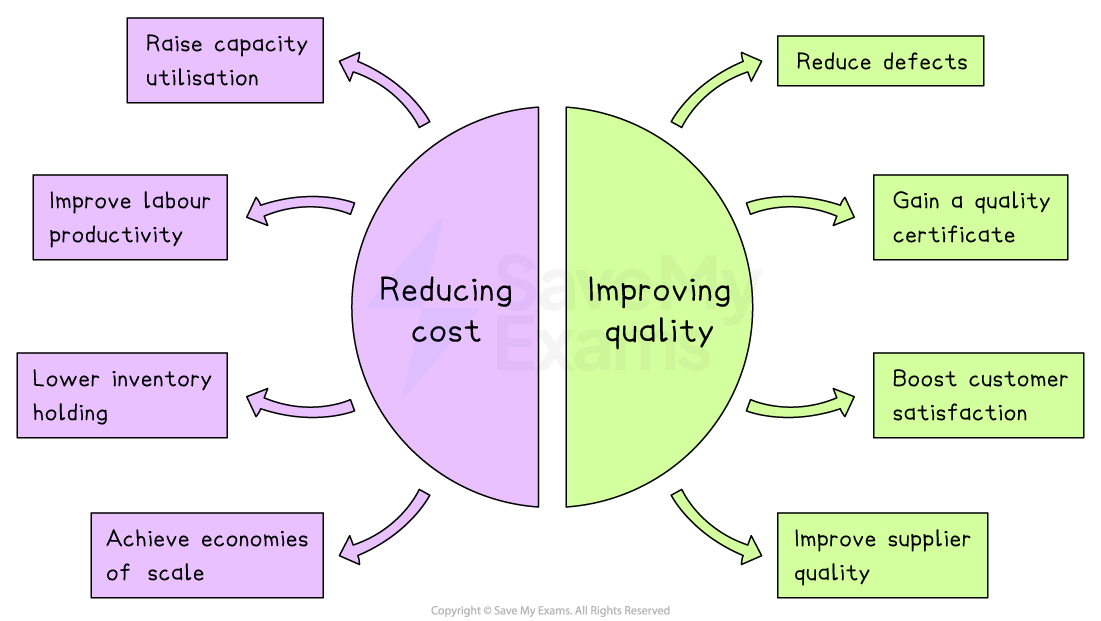Setting Operational Objectives (AQA A Level Business): Revision Note
Exam code: 7132
An introduction to operational objectives
Operational objectives are short-term goals set by the operations function to help the business run more efficiently and meet its overall aims
They focus on how products are made or services are delivered and typically include:
costs — keeping production or service delivery as efficient and cost-effective as possible
quality — ensuring products or services meet customer expectations
speed of response — how quickly the business can meet customer demand
flexibility — the ability to adapt to changes in demand or customise products
environmental objectives — minimising the business’s impact on the environment
added value — increasing the value of a product or service through design, quality or customer service
Each of these areas helps the business improve its competitiveness and customer satisfaction
More detail on each objective is below
Costs and quality
Operations objectives often focus on reducing costs or improving quality
Spending less to make each product leaves a firm with more gross profit or allows it to lower its prices to beat rivals
Products that work well every time keep customers happy and loyal, protecting a brand’s good name
Objectives to reduce costs and improve quality

Reducing costs
Common objectives a business may set to reduce costs include:
raising capacity utilisation
This spreads fixed costs over more output, lowering the unit cost
E.g. run the factory at 90% of available hours rather than 70%.
improving labour productivity
This means fewer labour hours are needed for the same output, lowering wage costs
E.g. increase units produced per employee by 10% through better training
lowering inventory holding
This frees cash tied up in materials and cuts storage, insurance and spoilage costs
E.g. switch from holding 30 days’ stock to 10 days’ stock through just‑in‑time deliveries
achieving purchasing economies of scale
Direct costs fall, lowering the overall unit cost
E.g. negotiate bulk contracts to lower raw material prices by 5%
Improving quality
Objectives focused on improving quality may include:
reducing defects
Fewer defects mean happier customers and fewer returns
E.g. lower the proportion of faulty units from 3% to 0.5% by adding extra final quality checks
gaining an industry quality certificate (e.g. ISO 9001)
Certification reassures buyers that the firm follows reliable standardised procedures
Pass the quality audit and earn the certification within 12 months
boosting customer satisfaction scores
Direct feedback confirms that customers value the level of quality of goods
E.g. increase satisfaction survey ratings from 82% to 90% by updating user instructions
improving supplier quality
Better inputs mean fewer problems during production
E.g. require key suppliers to hit 99% on‑time, defect‑free deliveries
Flexibility and speed of response
Flexibility matters because customer tastes and order sizes can change without warning
A flexible business can switch products or change the volume of output quickly, preventing lost sales or overstocking
Speed of response is vital because modern buyers expect rapid delivery
Cutting lead times keeps customers satisfied, earns repeat business and provides a competitive edge over slower rivals
Objectives to improve flexibility or reduce speed of response could include:
a multi‑skilled workforce
Staff can fill gaps or swap tasks quickly when demand changes
E.g. train every staff member to run at least two different machines
modular product design
New versions of products can be launched quickly without redesigning the whole item
E.g. introduce common parts that clip together in different ways in product manufacture
preventative maintenance
Keep production lines running and orders on schedule
E.g. introduce weekly machine checks to reduce unexpected breakdowns
Environmental objectives
Operations objectives with an environmental focus matter because a business now has to meet stricter environmental laws, rising energy costs and growing customer concern about sustainability
Setting objectives, such as cutting carbon emissions, reducing packaging waste or using renewable energy, helps a business adhere to the law, save money and gain environmentally conscious customers
Examples of environment‑focused operational objectives
Business | Objective | Tactics |
|---|---|---|
IKEA |
|
|
Unilever |
|
|
Added value
Adding value is the process of taking raw materials and using them in such a way that the end product created is worth more than the cost of the raw materials used to create it
The added value is the difference between the price that is charged to the customer and the cost of inputs required to create the product
E.g. customers are prepared to pay more for potatoes when they are packaged as oven chips than they would be willing to pay for a bag of whole potatoes
If value is not added to the materials and components that a business buys, fixed costs cannot be paid and no profit will be made
Examples of operational objectives focused on added value
Business | Operations objective | Added value |
|---|---|---|
Tesla |
|
|
Starbucks |
|
|
Nike |
|
|

Unlock more, it's free!
Did this page help you?